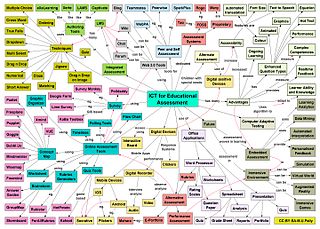Related Research Articles
The digital divide is the unequal access to digital technology, including smartphones, tablets, laptops, and the internet. The digital divide creates a division and inequality around access to information and resources. In the Information Age in which information and communication technologies (ICTs) have eclipsed manufacturing technologies as the basis for world economies and social connectivity, people without access to the Internet and other ICTs are at a socio-economic disadvantage, for they are unable or less able to find and apply for jobs, shop and learn.
The global digital divide describes global disparities, primarily between developed and developing countries, in regards to access to computing and information resources such as the Internet and the opportunities derived from such access.

Information and communications technology (ICT) is an extensional term for information technology (IT) that stresses the role of unified communications and the integration of telecommunications and computers, as well as necessary enterprise software, middleware, storage and audiovisual, that enable users to access, store, transmit, understand and manipulate information.

A telecentre is a public place where people can access computers, the Internet, and other digital technologies that enable them to gather information, create, learn, and communicate with others while they develop essential digital skills. Telecentres exist in almost every country, although they sometimes go by a different names including public internet access center (PIAP), village knowledge center, infocenter, Telecottage, Electronic Village Hall, community technology center (CTC), community multimedia center (CMC), multipurpose community telecentre (MCT), Common/Citizen Service Centre (CSC) and school-based telecentre. While each telecentre is different, their common focus is on the use of digital technologies to support community, economic, educational, and social development—reducing isolation, bridging the digital divide, promoting health issues, creating economic opportunities, and reaching out to youth for example.

Education in South Africa is governed by two national departments, namely the Department of Basic Education (DBE), which is responsible for primary and secondary schools, and the Department of Higher Education and Training (DHET), which is responsible for tertiary education and vocational training. Prior to 2009, both departments were represented in a single Department of Education. Among sub-Saharan African countries, South Africa has one of the highest literacy rates. According to The World Factbook - Central Intelligence Agency as of 2019, 95% of the population age 15 and over can read and write in South Africa were respectively literate.
Digital literacy is an individual's ability to find, evaluate, and communicate information using typing or digital media platforms. It is a combination of both technical and cognitive abilities in using information and communication technologies to create, evaluate, and share information.
Over the past decade, there has been an increase in the use of information and communications technologies (ICTs) in China. As the largest developing country in the world, China faces a severe digital divide, which exists not only between mainland China and the developed countries, but also among its own regions and social groups.
Computer technology for developing areas is a field focused on using technology to improve the quality of life and support economic development in regions with limited access to resources and infrastructure. This area of research seeks to address the digital divide, which refers to the gap between those who have access to technology and those who do not, and the resulting inequalities in education, healthcare, and economic opportunities.
The digital divide in the United States refers to inequalities between individuals, households, and other groups of different demographic and socioeconomic levels in access to information and communication technologies ("ICTs") and in the knowledge and skills needed to effectively use the information gained from connecting.
The digital divide is described as the characterization of the gap between individuals or countries that have access to technology and individuals or countries that do not. This also includes, but is not limited to: access to computers, internet, and information literacy. General contributions to the digital divide are geography and next generational users. Next generational users are more involved with using devices that can connect to the internet, while the geography factor focuses more on how an individual's location put them at an advantage or disadvantage to compete with the digital age. However, only a handful on people and communities are being represented. Underdeveloped geographical locations, like certain regions of the continent of Africa serves as one of the underrepresented minorities. In particular, South Africa faces many developmental problems that make it one of the more complex societies in the world to map the digital divide in. The country is divided by ethnic inequality and discrepancies in the level of development between different sectors. These obstacles result in disparities in access to information and communications technology (ICT). This disparity is commonly known as the digital divide. There has been another major contributor, namely, Telkom and its monopolistic hold on the progress of ICT in South Africa. South Africa faces unique challenges in addressing the digital divide, including ethnic inequality, disparities in development levels between different sectors, and a historically monopolistic telecommunications industry. Efforts to bridge the digital divide in South Africa involve a combination of government initiatives, non-governmental organizations (NGOs), non-profit organizations (NPOs), and public-private partnerships, all working towards increasing access to technology, promoting digital literacy, and enhancing digital skills among the population.

The digital divide in Canada refers to the discrepancy that exists between Canadians who have access to information and communication technologies (ICT) and the benefits they provide compared to those who do not. This divide can be the result of many factors, including high costs for technology and online access, differences in the availability of online connectivity resources in different locations across the country, and lacking digital literacy. The digital divide in Canada also stems from income inequality among Canadians and differences in online practices exhibited by those of different age, gender, first language, and cultural background.
Educational technology in sub-Saharan Africa refers to the promotion, development and use of information and communication technologies (ICT), m-learning, media, and other technological tools to improve aspects of education in sub-Saharan Africa. Since the 1960s, various information and communication technologies have aroused strong interest in sub-Saharan Africa as a way of increasing access to education, and enhancing its quality and fairness.

The digital divide is a term used to describe the disadvantage in access to information which people without access to ICT suffer. Nigeria's digital divide refers to the inequality of Nigerian individuals, groups, or organizations with regard to access to Information and communications technology (ICT) infrastructure or to the internet for daily activities. The digital divide has been attributed to many factors among which is the high cost of computer equipment, lack of ICT skill and poor knowledge of available search engines. Lack of access to ICT makes it difficult for people to access information. The benefits of having access to ICT are numerous. ICT has the potential to promote other sectors of the economy such as agriculture, education, health, bank, defence etc. In times of emergency, ICT becomes an indispensable tool for overcoming the barriers of time and distance. Education, lack of electrical infrastructure, income, urban drift, and a variety of other social and political factors contribute to Nigeria's growing digital divide.

The digital divide in Germany, the second most populous state and leading economic powerhouse in Europe, refers to the ever-growing gap between members of society without computer or Internet access and those with access. There are several factors contributing to the digital divide in Germany, including age, gender, family structure, education, ethnicity, and motivation. With a large market of Information and Communications Technology (ICT) in Germany, there are still areas that don't have access to high-speed internet. Internet access in Germany is more available in big cities compared to rural communities. The German government has taken initiative to increase internet access through the rural communities by adding free internet access throughout the communities, as well as, increase internet education in schools.

The digital divide is an economic and social inequality with regard to access to, use of, or impact of information and communication technologies (ICT). Factors causing the divide can vary depending on the country and culture, as can the potential solutions for minimizing or closing the divide.

The digital divide in Thailand refers to the economic, educational, and social inequalities between the Thai people who have access to information and communications technology (ICT) and those who do not. Thailand is a developing country within Southeast Asia, and is currently confronted with this problem. There are a number of factors that determine the digital divide within a country, including income, choice of technologies and socioeconomic factors. ICT development and mobile penetration are strongly correlated with economic growth and social benefits.
The digital divide in Japan refers to inequalities between individuals, households, and other groups of different demographic and socioeconomic levels in Japan in access to information and communication technologies ("ICTs") and in the knowledge and skills needed to effectively use the information gained from connecting.
Digital inclusion involves the activities necessary to ensure equitable access to and use of information and communication technologies for participation in social and economic life including for education, social services, health, social and community participation. Digital inclusion includes access to affordable broadband Internet services, Internet-enabled devices, access to digital literacy training, quality technical support, and applications and online content designed to enable and encourage self-sufficiency, participation, and collaboration. Related concepts include digital divide, digital exclusion and digital inequality however digital inclusion focuses more on the strategies, policies and programs required to address the digital divide.
Gender digital divide is defined as gender biases coded into technology products, technology sector and digital skills education.

The digital divide in Colombia refers to inequalities between individuals, households, and other groups of different demographic and socioeconomic levels. More specifically, differences in access to information and communication technologies ("ICTs") and in the knowledge and skills needed to effectively use the information gained from connecting.
References
- ↑ "Definition of DIGITAL DIVIDE". www.merriam-webster.com. Retrieved 2017-10-06.
- ↑ FAZIHARUDEAN, TM (2004). "BRIDGING THE KNOWLEDGE AND DIGITAL DIVIDES". Knowledge-Based Economy Master Plan– via Unpan.
- 1 2 Dato’ Tengku Feissal, Tengku Mohamed Faziharudean bin (2005). "DIGITAL DIVIDE IN MALAYSIA: EXAMINING THE ISSUES OF INCOME, WORKPLACE AND GEOGRAPHICAL DIFFERENCE IN DIFFUSING ICT TO THE MASS PUBLIC". 所得、職場環境、地域格差がマレーシアにおける情報格差(デジタルディバイド) および情報通信技術の普及に与える影響に関する研究.
- ↑ "Older Adults and Technology Use". Pew Research Center: Internet, Science & Tech. 2014-04-03. Retrieved 2017-10-23.
- ↑ "1. Technology use among seniors". Pew Research Center: Internet, Science & Tech. 2017-05-17. Retrieved 2017-10-23.
- 1 2 3 4 "Telecentre Network in Malaysia: Bridging the Digital Divide". Telecentre. Retrieved 2017-10-23.
- 1 2 "Infrastructure Report: Bridging the digital divide". 2014-10-10. Retrieved 2017-10-23.
- 1 2 Rozhan M. Idrus; Hanafi Atan (2004). "Closing the Digital Divide in Malaysia-Catching Them Young". Malaysian Online Journal of Instructional Technology. 1 (1): 33–40. Retrieved 2017-10-23.
- 1 2 3 Ibrahim, Mohamad Zaki; Chan, Geraldine (2008). "Conceptualising the Network Society in Malaysia". Asian Journal of Social Science. 36 (5): 773–791. doi:10.1163/156853108X364226.
- ↑ Majid, Shaheen; Fanilievna Abazova, Alfia (1999). "Computer literacy and use of electronic information sources by academics: A case study of International Islamic University Malaysia". Asian Libraries. 8 (4): 100–111. doi:10.1108/10176749910275867.
- ↑ "Infrastructure Report: Bridging the digital divide". 2014-10-10. Retrieved 2017-10-23.